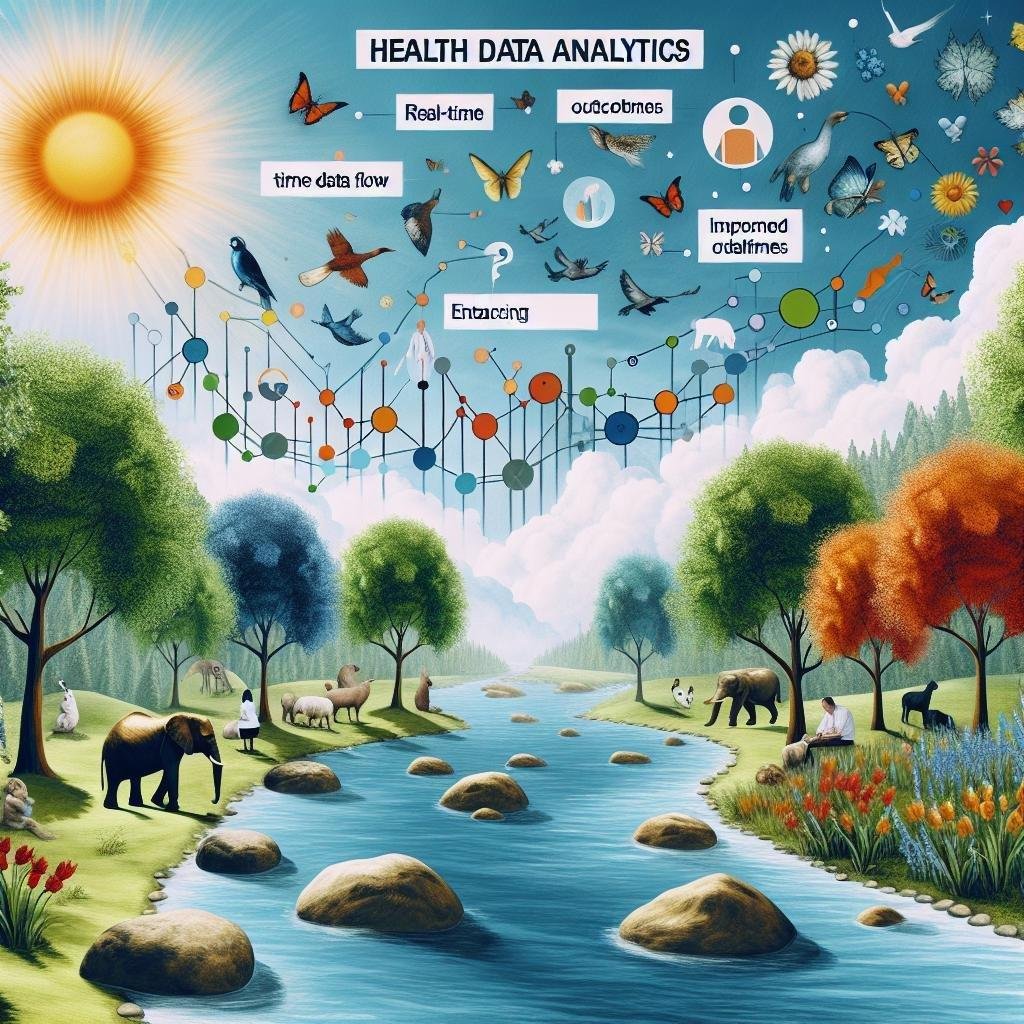In today’s rapidly evolving healthcare landscape, the integration of real-time health data analytics is transforming the approach to patient care and clinical decision-making. As the demand for improved patient outcomes intensifies, healthcare providers are increasingly leveraging advanced analytics to harness the vast amounts of data generated within healthcare systems. This article explores the critical role of real-time health data analytics in enhancing patient outcomes, examining its applications in predictive modeling, personalized treatment plans, and timely intervention strategies. By facilitating immediate access to actionable insights, these analytics not only streamline workflows but also empower clinicians to make informed decisions that significantly impact patient health trajectories. As we delve into the technological advancements and methodologies underpinning this paradigm shift, we will highlight successful case studies and explore the potential challenges and ethical considerations that accompany the deployment of real-time data analytics in diverse clinical settings.
Table of Contents
- Real-Time Data Integration for Personalized Treatment Plans
- Predictive Analytics in Patient Monitoring and Intervention
- Utilizing Machine Learning for Outcome Optimization
- Strategies for Implementing Data-Driven Decision Making in Healthcare
- In Retrospect
Real-Time Data Integration for Personalized Treatment Plans
Incorporating real-time data integration into the healthcare framework allows practitioners to develop highly tailored treatment plans based on individual patient needs. By utilizing electronic health records (EHRs), wearable devices, and mobile health applications, healthcare providers can gather and analyze patient data instantly. This timely access to information enables clinicians to adjust treatments proactively, therefore, improving adherence to therapy regimens and enhancing clinical outcomes. Key components that make this integration successful include:
- Interoperability: Seamless communication between disparate health systems ensures that all relevant data is collected efficiently.
- Real-Time Monitoring: Continuous assessments via remote patient monitoring technologies facilitate dynamic treatment adjustments.
- Machine Learning Algorithms: Advanced analytics tools can predict potential complications, enabling preemptive measures.
As patients engage more with their own health data, they become active participants in their care. By visualizing trends and insights from their real-time data, patients can better understand their health status and the effects of their treatment. This partnership empowers patients to collaborate with healthcare providers more effectively while leveraging the following metrics:
| Metrics | Value |
|---|---|
| Patient Engagement Rate | 75% |
| Treatment Adherence Improvement | 30% |
| Reduction in ER Visits | 20% |
Predictive Analytics in Patient Monitoring and Intervention
Predictive analytics plays a pivotal role in revolutionizing patient monitoring and intervention. By harnessing the power of real-time health data, healthcare professionals can identify at-risk patients with unprecedented accuracy. This data-driven approach enables clinicians to monitor various vital signs, symptoms, and lifestyle factors, allowing them to pinpoint trends and predict potential health crises before they occur. Key components include:
- Data Collection: Continuous gathering of patient data from wearable devices and health records.
- Algorithm Development: Sophisticated algorithms analyze data for patterns indicating deteriorating health.
- Proactive Interventions: Targeted actions such as medication adjustments or lifestyle recommendations based on predictive insights.
Implementing predictive analytics also enhances communication between care teams and patients. By providing tailored feedback, healthcare systems can foster patient engagement and adherence to treatment plans. A structured intervention schedule is essential for maximizing results. The table below illustrates an example of predictive intervention strategies based on risk assessment:
| Risk Level | Intervention Strategy | Frequency of Monitoring |
|---|---|---|
| High | Immediate clinical intervention and daily check-ins | Daily |
| Moderate | Regular follow-ups with telehealth | Weekly |
| Low | Preventive health education and monthly assessments | Monthly |
Utilizing Machine Learning for Outcome Optimization
Machine learning models are increasingly being leveraged to analyze large datasets, providing healthcare professionals with actionable insights for patient management. By employing algorithms that learn from historical health data, we can identify patterns and predict outcomes with remarkable accuracy. For instance, predictive analytics can help in determining which patients are at risk for certain conditions, allowing for early interventions. This process not only enhances decision-making but also optimizes resource allocation by focusing efforts where they are most needed.
To implement these machine learning solutions effectively, several key components must be integrated into the healthcare workflow:
- Data Integration: Seamlessly amalgamating disparate data sources ensures comprehensive analysis.
- Real-Time Monitoring: Continuous data input facilitates immediate response actions and adjustments in treatment plans.
- User-Friendly Dashboards: Visual representations of data trends empower healthcare providers to make informed decisions expediently.
| Machine Learning Technique | Application in Healthcare |
|---|---|
| Supervised Learning | Predicting patient outcomes based on historical data. |
| Unsupervised Learning | Identifying patient subgroups for targeted treatments. |
| Reinforcement Learning | Optimizing treatment protocols through trial-and-error feedback. |
Strategies for Implementing Data-Driven Decision Making in Healthcare
To effectively harness the power of data analytics in healthcare, organizations should first focus on establishing a robust data governance framework. This involves defining clear roles and responsibilities for data management while promoting a culture of data literacy among healthcare professionals. Emphasizing training programs that educate staff on interpreting and utilizing data can significantly enhance their decision-making capabilities. Furthermore, leveraging technologies such as Electronic Health Records (EHR) and Health Information Exchanges (HIE) is essential to centralize and streamline access to real-time patient data, fostering seamless collaboration among stakeholders.
Another critical strategy is to integrate predictive analytics into everyday operations. This can support proactive patient care, allowing healthcare providers to identify at-risk populations based on historical data patterns. Implementing tools that visualize data trends can aid in recognizing emerging health issues before they escalate, minimizing hospital readmissions and improving patient satisfaction. Additionally, involving patients in the analytic process through transparent communication about data usage can enhance trust and treatment adherence. Consider the following table that outlines key components of this approach:
| Component | Description |
|---|---|
| Data Governance | Establish roles and promote data literacy among staff. |
| Predictive Analytics | Utilize historical data to identify patients at risk. |
| Patient Involvement | Engage patients in understanding data applications. |
In Retrospect
the integration of real-time health data analytics stands as a transformative frontier in the pursuit of enhanced patient outcomes. By harnessing the power of advanced algorithms, machine learning, and continuous data streams, healthcare providers can leverage timely insights to inform clinical decision-making, streamline care processes, and personalize treatment pathways. The transition from reactive to proactive healthcare models not only elevates patient engagement but also fosters a culture of continuous improvement within healthcare systems.
As we look to the future, it is imperative that stakeholders—including healthcare organizations, technology developers, and regulatory bodies—collaborate to address challenges related to data interoperability, security, and patient privacy. By creating robust frameworks for data governance and promoting health literacy among patients, we can ensure that the benefits of real-time analytics are equitably realized across diverse populations.
Ultimately, the journey towards optimized patient outcomes through real-time health data analytics is not merely a technological advancement; it is a commitment to enhancing the quality of care and improving the overall health of communities. As we continue to innovate and adapt, the potential for transformative impact within the healthcare landscape is enormous, paving the way for a more proactive, efficient, and patient-centered approach to healthcare delivery.




